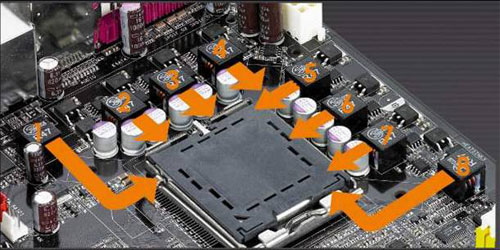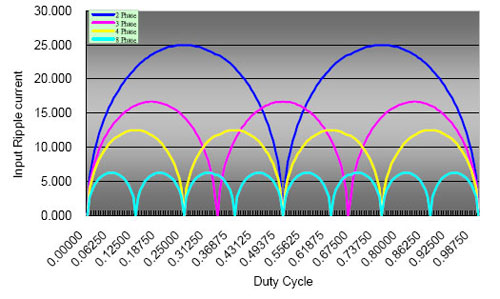Asus A8N32-SLI Deluxe: NVIDIA Dual x16 for the Athlon 64
by Wesley Fink on November 6, 2005 9:00 AM EST- Posted in
- Motherboards
8-Phase Power and Dual x16 PCIe
Two areas really stand out with the new Asus A8N32-SLI. First, this is the launch of a true dual x16 SLI board. That means that you can bridge two video cards at full x16 speed in each slot instead of the x8 speed of current SLI.
8-Phase Power
The new Asus 32-SLI boards, both the recently tested P5N32-SLI for Intel processors and this A8N32-SLI for AMD, are the first 8-phase desktop boards that we have tested. Those who have questioned whether the design is truly 8-phase will be interested in this shot with the MOSFET heatsinks removed on the Intel version. There are 8 coils and 8 banks of MOSFETS along the two sides of the CPU.
Low ripple voltage can stabilize the CPU at working voltage, but it also can increase the over-clocking margin. An Asus White Paper uses the analogy of ripple voltage being like waves in an ocean and the CPU is like a boat. It is very hard for a boat to go forward in big waves (High ripple voltage), and the big waves can even turn the boat around (Burnout of the CPU). On the other hand, it is easy for a boat to move forward in small waves (Low ripple voltage), and the boat can even go faster (Overclocking the CPU) in an ocean with small waves.
The other advantages of 8-phase are a current reduction of up to 50% compared to 4-phase, which can yield a power reduction of about 25% over 4-phase. This even applies to a reduction in power consumption in a high-end CPU. Asus claims that a CPU requiring 130W in a 4-phase design will see a 10% reduction in power consumption in an 8-phase design.
Dual x16 PCIe
While both the P5N32-SLI for Intel and this A8N32-SLI for AMD provide two full speed 16-bit slots for SLI, they use a slightly different set of chipsets to drive this feature. This AMD version uses what is basically a C51 Northbridge chip without integrated graphics for the A8N32-SLI North Bridge and an nForce4 SLI chip for the South Bridge. In this hybrid design, each bridge drives one x16 slot and a total of 40 PCIe lanes are available to the board.
The Intel processor solution from NVIDIA uses the Intel C19 for the Northbridge and the same nForce4 SLI for the South Bridge. The 2 chips communicate via a Hypertransport link just like the chips in the AMD solution.
Whatever the differences in approach, both the Intel and AMD versions provide full dual x16 PCIe slots, which can be combined into Dual x16 SLI video. There are also other potential design uses as you saw in the Gigabyte quad PCIe review, where the board could enable four x8 PCIe slots to drive up to 10 monitors.
Two areas really stand out with the new Asus A8N32-SLI. First, this is the launch of a true dual x16 SLI board. That means that you can bridge two video cards at full x16 speed in each slot instead of the x8 speed of current SLI.
8-Phase Power
The new Asus 32-SLI boards, both the recently tested P5N32-SLI for Intel processors and this A8N32-SLI for AMD, are the first 8-phase desktop boards that we have tested. Those who have questioned whether the design is truly 8-phase will be interested in this shot with the MOSFET heatsinks removed on the Intel version. There are 8 coils and 8 banks of MOSFETS along the two sides of the CPU.


| CPU Current 100A | 2-Phase | 3-Phase | 4-Phase | 8-Phase |
| Input Ripple Current (A) | 22.63 | 16.508 | 12.359 | 4.463 |
Low ripple voltage can stabilize the CPU at working voltage, but it also can increase the over-clocking margin. An Asus White Paper uses the analogy of ripple voltage being like waves in an ocean and the CPU is like a boat. It is very hard for a boat to go forward in big waves (High ripple voltage), and the big waves can even turn the boat around (Burnout of the CPU). On the other hand, it is easy for a boat to move forward in small waves (Low ripple voltage), and the boat can even go faster (Overclocking the CPU) in an ocean with small waves.
The other advantages of 8-phase are a current reduction of up to 50% compared to 4-phase, which can yield a power reduction of about 25% over 4-phase. This even applies to a reduction in power consumption in a high-end CPU. Asus claims that a CPU requiring 130W in a 4-phase design will see a 10% reduction in power consumption in an 8-phase design.

Dual x16 PCIe
While both the P5N32-SLI for Intel and this A8N32-SLI for AMD provide two full speed 16-bit slots for SLI, they use a slightly different set of chipsets to drive this feature. This AMD version uses what is basically a C51 Northbridge chip without integrated graphics for the A8N32-SLI North Bridge and an nForce4 SLI chip for the South Bridge. In this hybrid design, each bridge drives one x16 slot and a total of 40 PCIe lanes are available to the board.
The Intel processor solution from NVIDIA uses the Intel C19 for the Northbridge and the same nForce4 SLI for the South Bridge. The 2 chips communicate via a Hypertransport link just like the chips in the AMD solution.
Whatever the differences in approach, both the Intel and AMD versions provide full dual x16 PCIe slots, which can be combined into Dual x16 SLI video. There are also other potential design uses as you saw in the Gigabyte quad PCIe review, where the board could enable four x8 PCIe slots to drive up to 10 monitors.










95 Comments
View All Comments
Per Hansson - Sunday, November 6, 2005 - link
Hi, what type of capacitors did Asus choose to use on this mainboard?It looks like all caps are of the same type, (bar the CPU filter caps) is it Chemicon perhaps?
Klaasman - Sunday, November 6, 2005 - link
You guys at Anandtech should try cleaning the dust out of your HSF once in a while.Wesley Fink - Sunday, November 6, 2005 - link
We have received a number of emails questioning our results since some other sites who found twice the performance with Dual x16 tested with the nVidia SLI-AA option enabled with Coolbits in very recent nVidia drivers.We have complete results of SLI-AA testing with Far Cry - Regulator, the same game tested by sites claiming the 50% performance gain for Dual x16, but we no increase at all in SLI-AA performance.
ALL components except the motherboard are the same. We even moved the hard drive between the systems to make SURE everything but the motherboard remained the same. Results were the Average of two runs with the very latest 81.87 videodrivers. Memory was 2x512MB of our standard OCZ PC3200 Platinum Rev. 2 at 2-2-2-7. Memory and CPU were exactly the same in both systems, and the same MSI 7800GTX cards were used for benchmarking.
nVidia SLI-AA Mode - Far Cry - Regulator Demo - 1600x1200
8X SLI-AA 16X SLI-AA
Asus A8N32-SLI Deluxe 37.22 20.59
DFI LANParty nF4 37.89 22.19
As you clearly see, there is NO difference with nVidia SLI-AA between Dual x8 and Dual x16. In fact the Dual x8 scores are slightly faster, but they are well within error margin and I would call them equivalent - the same.
Live - Sunday, November 6, 2005 - link
Nice to see this one cleard up. To bad you where right and they where wrong, performance wise that is.mctmcpoop - Saturday, November 5, 2005 - link
Cound you re-test and compare the result from different X16 bus in A8N32 ? If the X16 slot result from the NF4 chipset is lower compare to X16 from C51D , we can be sure that the C51D X16 is much faster than NF4 chipsetWesley Fink - Saturday, November 5, 2005 - link
This is a really good idea. The only problem is the Micro ATX boards that have this North Bridge do not normally have the memory timing options and other tweaks to allow a direct comparison. Also with an enabled integrated video on the C51 north bridge we are introducing a new variable. We will probably have to wait for other Dual x16 boards to see if we can duplicate these results on the newest, most demanding games.mctmcpoop - Saturday, November 5, 2005 - link
What I mean is test both of the X16 slot on A8N32 , one X16 bus should be from C51D pci express tunnel chip , the other X16 slot bus should be from the NF4 chip as other normal SLI board ... So if the right X16 slot get good score compare to left X16 slot , that means C51D chip has better design of the pci express x16 bus ...Wesley Fink - Sunday, November 6, 2005 - link
I ran some quick tests comparing the North x16 slot (nearest to CPU) and the South x16 slot on the Asus in the 3 new games that showed the big single-video increases. The South x16 slot was consistently slower than the one nearest the CPU by 2% to 6.7% in our single video performance tests. Perhaps there are difference in performance of the MCP51 and nF4 SLI which each drive one of these slots. We will look at these results again in future Dual x16 board reviews.lopri - Saturday, November 5, 2005 - link
Another question for Wesley:When you say OC isn't as good with SLI as with a single video card setup, is it in general? Or this particular board? Also, what's the reason for it? CPU? Chipset? Power regulation on the board?
Thanks again for a great review! I'm eagerly waiting for this board!
Wesley Fink - Saturday, November 5, 2005 - link
We have noticed that SLI will not overclock as high on other nForce4 boards as well, but I can't tell you the max on each one for SLI. I made this comment because I couldn't duplicate an overclock I had run earlier on this board, realized I had SLI set-up, removed the 2nd card and ran a few quick tests to see the impact of SLI on maximum overclock.